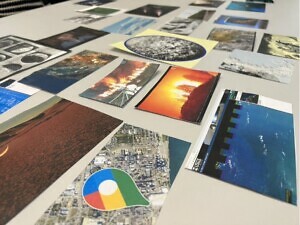In April, an interdisciplinary group of artists and researchers met at Darwin College for a two-day exploratory workshop, ‘Remote Sensing – Exploring Practices between the Arts, Sciences, and Humanities‘. Throughout the 2022 – 2023 academic year, this CRASSH research network met in a series of hybrid discussions, to look for common ground in our different approaches to studying ice and icy places. Taking the history of sciences in hard-to-reach places like the polar regions as our starting point, we worked to develop shared methods for thinking and feeling our way across distance.
In the workshop, our aim was to bring together scientific ideas about the collection of environmental data with other approaches to ‘distant feeling’ from the arts and humanities, in order to think together about how so-called remote places are experienced and understood today. How do we—scholars, artists, historians, scientists—get in touch with remote subjects? If we consider that remoteness is an inevitable (and perhaps underappreciated) aspect of work in the arts and humanities, we sought productive dialogue with scientific conceptions of remote sensing. In other words, when ‘going there’ is not an option, how can instruments, imagination, and embodied practices work to span the distance? How do scientific, aesthetic and conceptual takes on data materials from satellites and drones challenge ways of caring and knowing, and how can we reassess ideas of ‘views from nowhere’ or ‘ground truthing’ in such dialogues?
Day 1 | Sensing oceanic ecologies
Chair: Anna Guasco (University of Cambridge)
How does remote sensing imagine, construct, and configure oceanic ecologies? The ocean is often imagined, particularly by Western sciences, variously as an unfathomable abyss, a frontier, a counterpart to outer space, and a watery landscape inhospitable to (human) life, yet it is home to a wide array of multispecies communities and ecologies, with which human communities are inextricably entwined. The ocean challenges anthropogenic observation; remote sensing can be a tool for fathoming unfathomable seas. Remote sensing brings with it, though, complexities and tensions, including those related to scales of observation. This panel examined how different forms of remote sensing engage with scale, biological communities, environmental change, and multispecies relations in oceanic ecologies.
Panellists were:
- Jennifer Jackson (British Antarctic Survey)
- Andra Pop-Jurj (researcher, Forensic Architecture)
- Kate Sammler (Helmholtz Institute for Functional Marine Biodiversity)
Orbital reveries
Chair: Richard A Carter
In our first collaborative activity, we worked collectively to produce interactive digital ‘maps’ of remote sensing. The ‘mapping’ application has been developed specially for this workshop by Richard A Carter. It is effectively an image viewer, in which the user’s gaze is limited to a defined window, and which can then be ‘navigated’ by pressing the arrow keys on the keyboard or on the screen. The end result is a scene that a user can wander across, encountering new ways of ‘reading’ it, and remote sensing, more generally. Annotations take the form of, for example, quotations, poetry, notes, reflections, keywords, and descriptions of the image itself – of what is shown, and perhaps what is not shown.
The idea behind this exercise was to inscribe satellite images with thoughts and associations concerning what remote sensing ‘means’, using the shapes and structures of the underlying image as a way of arranging these thoughts in space, paying attention to topographic, spectral, and metaphoric resonances. The end result of the orbital reveries exercise is a scene that a user can wander across, encountering new ways of ‘reading’ the landscape, and the medium of remote sensing more generally.
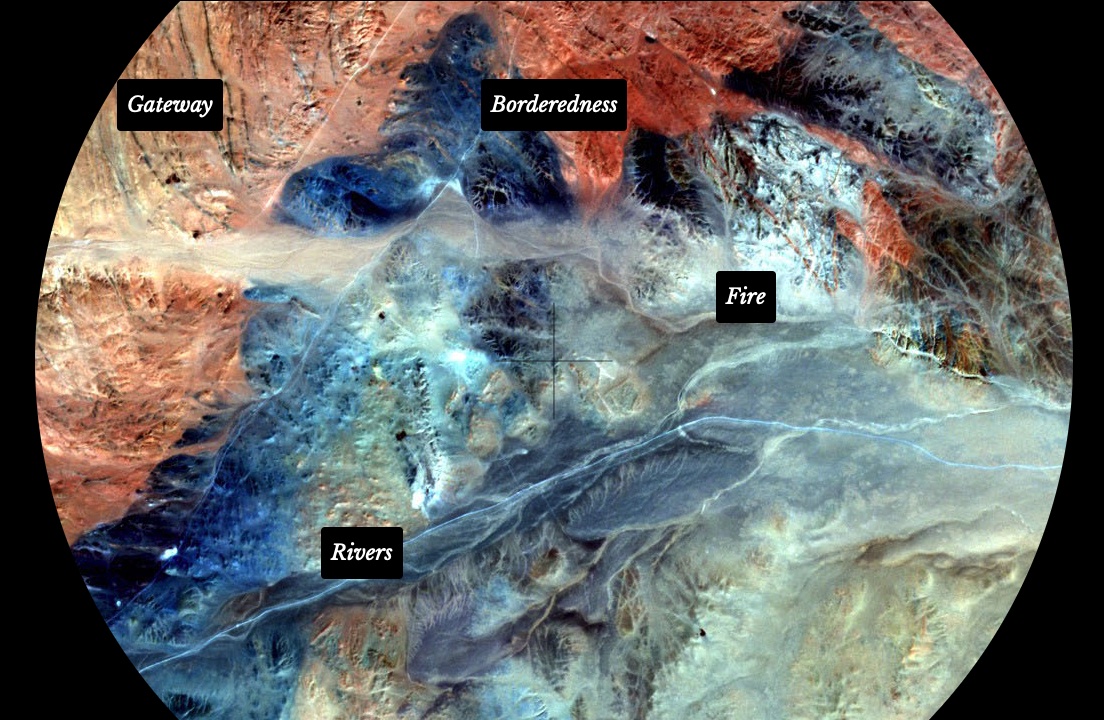
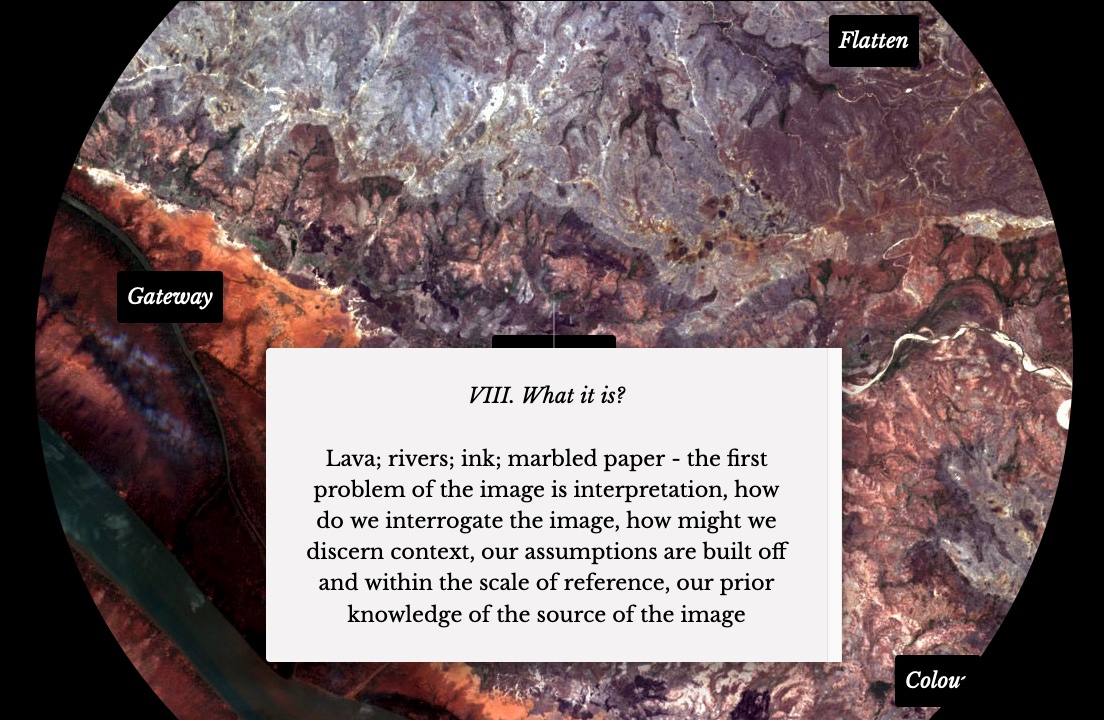
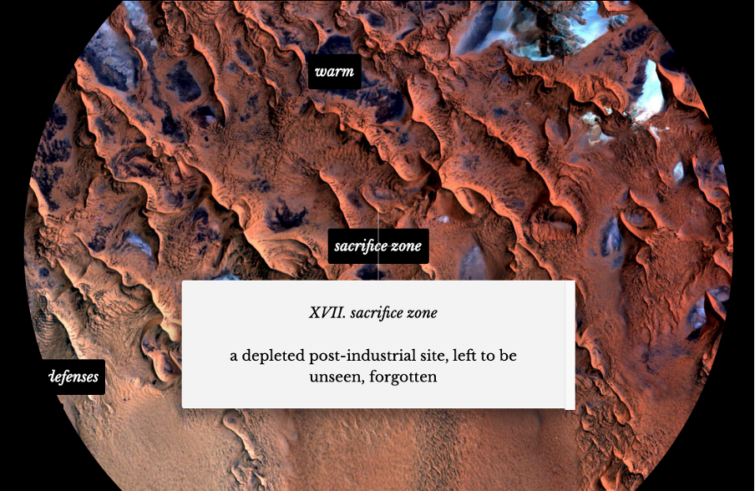
Orbital Reveries: group exercises lead by Richard A Carter
Senses and sensibilities: experiencing remote ice before remote sensing
Chair: Tom Simpson (University of Cambridge)
Long before the development of technologies that typify present-day remote sensing, experiences of ice often evoked themes of remoteness and proximity. Ice rarely seemed to be at a comfortable distance; it was instead intrusively present or frustratingly withdrawn. As well as demanding novel techniques and technologies to render it knowable and useable, icy encounters and their representations tended to evoke and convey high emotions, ranging from fear and aversion to longing and intimacy. Contributions to this panel consider a range of historical settings in which interacting with and comprehending frozen matter was a multi-sensory and affect-laden venture.
Panellists were:
- Christine Bichsel (University of Fribourg)
- Danielle Inkpen (Mount Allison University, online participant)
- Hanna Ljungh (Artist, Sweden)
- Alexis Rider (University of London)
Responsive museum
Chairs: Elizabeth Lewis Williams & Ruth MacIennan
At the Polar Museum, we explored distance on a more intimate scale, asking questions such as, what is the distance between a researcher or an artist and her subject? How can this distance be a space of possibility as well as uncertainty?
We began with a viewing of Ruth MacIennan’s film ‘Hero City’ (2016), in which footage of a research trip to the Russian Arctic is overlaid with ominous commentary from an imaginary future self, looking back on seemingly mundane scenes to search for the hidden meaning within them. From these small, mundane clips of everyday life, MacIennan constructs a fictional rumination on apocalypse and revolution, drawing attention to the act of ‘witnessing’ itself.
In the museum gallery, we practised being onlookers ourselves. Moving between exhibit objects behind glass and the items of the ‘handling collection’, participants gathered their impressions of interacting with objects with different senses, at different degrees of distance. Poet Elizabeth Lewis Williams led us in an exercise for gathering impressions and composing these into lyric forms. We were interested in how the role of imagination helps to bridge the gap between subject and object, even when the distance separating them is only a few inches. Like MacIennan’s narrator, we found voices to help us speak to and for the museum objects, and the results were something like a stage play with many characters speaking all at once.
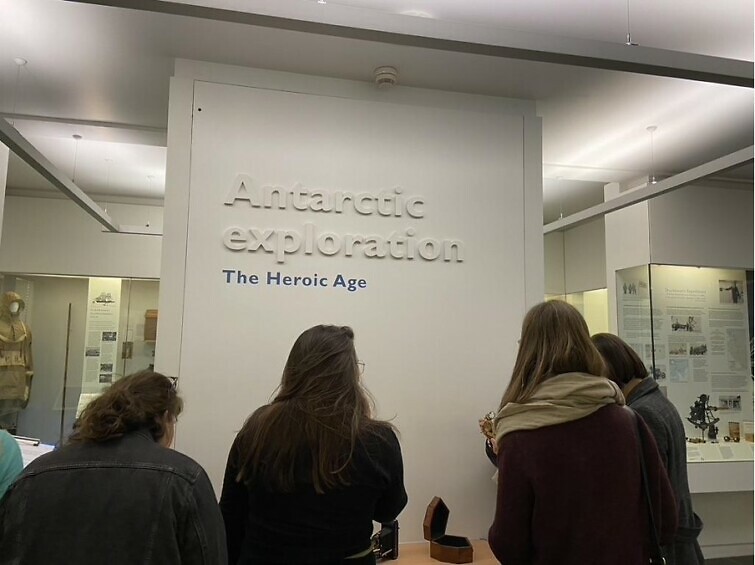
Scott Polar Museum exercise lead by Elizabeth Lewis
Bone carved silence.
Where did you come from?
The smell of cedar,
shards of wood and ice,
the sound of dry hand
touching wood, a connection
with the hand that made you,
a sense of finding your way.
I am what you made of me
I am communication of places
a carved map
a negotiation of knowledge.
*
I am too light, too warm, to be what I seem,
a silent image of a silent object
itself an impression of an absent original,
my true model endured for millenia;
I will be present for centuries –
a 3D printed fossil.
*
I am yellow tinted glasses,
Fragile and light.
I smell of old snow.
Day 2 | Visual atlas
Our understanding of remote sensing largely takes place in visual terms. In order to experiment with overlapping, intersecting, and resonating notions, we were interested in conducting a visual exercise inspired by aspects of Aby Warburg’s Bilderatlas Mnemosyne. To do this, we started with a set of images that we collectively generated, all relating in some way to practices and imaginations of remote sensing. These images might capture aspects of personal research trajectories, the history of remote sensing, its cultural manifestations, or scientific imagery productive of a remote view. Then from this set of disparate materials, we explored processes of intuitive ordering to generate organisational structures and relationships. In trying to find different logics in placing images in relation, by experimenting with their themes, visual languages, topics, and motifs, organisation and order parameters started crystallising.
We started this process with questions such as: what can we learn about imaginations and practices of remote sensing, about distance, scale, and gaze? What are the unexpected themes that come to the fore? How can we collectively bring knowledges about these images together, and what are the parameters to create structuring orders? What can we learn about our different aesthetic and visual literacies?
Emerging order principles ranged from ‘the wheel’ or ‘from concrete to abstract’. In some cases, images were arranged according to the distance involved; ‘degrees of separation’ as it were. Other ordering principles involved degrees of representations or formal structure, such as ‘the colour line’ which investigated the narratives that emerged when ordering images according to their colour and colour saturation. Another ‘keeling curve’ structure mapped images according to a temperature scale.
Bringing remote sensing down to earth
Chair: Mia Bennett (University of Washington)
Remote sensing is defined as the art, science, and technique of gathering information about an object without making physical contact with it. Satellites, which collect electromagnetic data about the Earth from space, are the paradigmatic (and orthodox) form of remote sensing, which is also often seen as synonymous with the act of imaging. Yet there are other, non-visual and non-machine-based forms of remote sensing. In northern Alaska, for instance, the Iñupiaq, an Arctic Indigenous whaling people, place a wooden oar into the ocean to listen for nearby cetaceans. Drawing on examples from the polar regions and beyond, this panel will seek to reimagine remote sensing along more expansive and multisensory lines. Such an effort at contemplating ‘counter remote sensing’ also aims to bring the lofty technology of remote sensing down to Earth by exposing its diverse political, economic, and cultural origins and revealing that those typically imagined as observed by remote sensing are often themselves observers, too.
Panellists were:
- Charles Brunette (Carleton University, Ottawa)
- Redell Olsen (Royal Holloway London)
- Sarab Sethi (Cambridge Conservation Initiative)
- Vera Tollmann (Leuphana University Lüneburg)
Sensory lexicon
The words we use to talk about remote sensing are many, and their meanings multifarious, moving in many directions at the same time. We wanted to begin to build a collective lexicon that reflects this complexity, by practising writing and rewriting definitions together. In small groups, we each chose a starting word and spent two minutes writing a short definition. At the end of the time, we passed our first definition to the next person around the circle, who then added a second definition, restating or elaborating upon the first. With each new definition, we explored what common spaces and contradictory meanings we could tease out from such seemingly straightforward words as ‘Signal’ ‘Noise’ ‘Data’ ‘Instrument’ and ‘Ice’.
When we shared these composite definitions within our groups, we found that surprising rhythms emerged; sometimes a group moved from technical explanations to more poetic ones, or else successive reiterations served to build and intensify the same set of ideas. Certain words tended to circulate among the definitions in one group, as well. What we experienced was the plasticity of language, its extreme social dimension, and its capacity for resonance and echo far beyond a single term or its standard definition.
Remote sensing – coming to terms with distance in art, science, history
In this keynote panel, we heard from practitioners of remote sensing in different disciplines as they reflect on the ways that remoteness is understood and experienced in their work. The panellists were Mia Bennett, a geographer at the University of Washington developing the field of ‘critical remote sensing’, Andrew Fleming, glaciologist and cartographer at the British Antarctic Survey and head of the MAGIC mapping unit, and Conny Freyer and Eva Rucki of Troika, an artist collective exploring the relationship between humanity, technology, and place.
This event was supported by the Cambridge Centre for Research in the Arts, Social Sciences, and Humanities (CRASSH), the British Society for the History of Science (BSHS), and Darwin College. Additional thanks to the Scott Polar Research Institute and Selwyn College.

